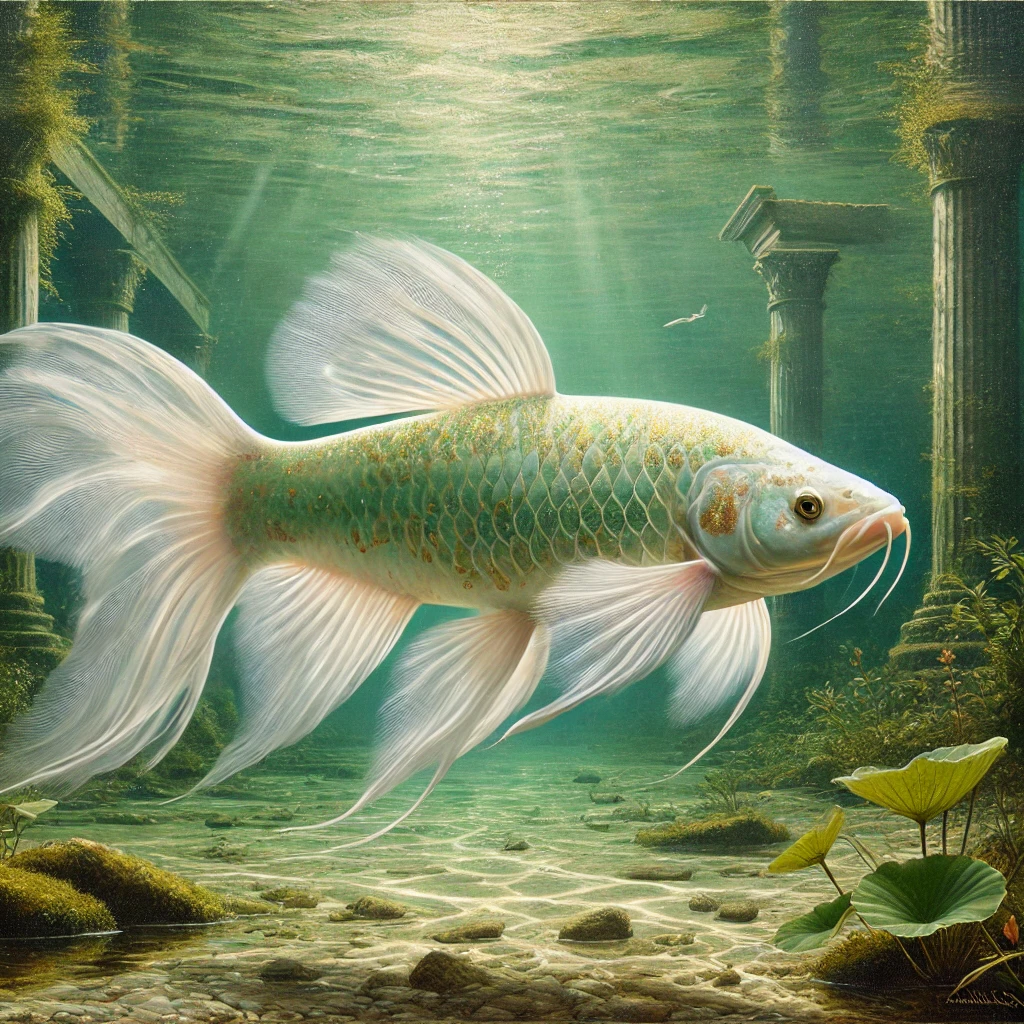Jadespines
"Not all treasure glitters in vaults. Some flickers beneath the reeds, wearing jade and gold like an emperor in exile."
They drift like ghosts of forgotten royalty, glistening in jade scales and bone-pale fins, their bodies speckled with gold like an Elfese emperor's ringed hand. To glimpse a Jadespine is to see beauty unspoiled by the rot of war or ruin. Found only in the calmest loughs and glassy rivers of Everwealth, these radiant fish are relics of a gentler age, hunted not for hunger, but for art. Though the land is scarred and its people harder still, the Jadespine glides on, a quiet defiance against the world’s decay.
Basic Information
Anatomy
The Jadespine bears an elongated, graceful form spanning 1 to 1.8 feet in length. Its body is smooth and lustrous like emerald glass, fluid panes of jade set to motion, inlaid with glimmering gold. Along its flanks, the broad, arching fins shimmer a ghostly white polished riverbone When the creature moves, the water around it flickers with refracted light, as if it swims through its own reflected memory. Lacking scales in the traditional sense, the Jadespine's skin is a hybrid surface, pliable but oddly firm, like polished gemstones set into flesh. Its delicate barbel filaments, drifting from the snout, serve both to sense food and brush affectionately against its kin.
Genetics and Reproduction
Jadespines spawn in clusters, favoring the flood-rich thaw of early spring. Dozens will gather in temple shallows and riverbeds near moonrise, swirling in luminous spirals while the females scatter hundreds of faintly glowing eggs across fine stones and silt. Males follow with silken plumes of milt, leaving fertility to the waters and fate. No care is given after the spawn. Most eggs feed the river. The rest? The beautiful few? They swim.
Growth Rate & Stages
- Driftborn (0-2 weeks): Nearly invisible save a faint shimmer.
- Fingerling (2 weeks-3 months): Thin as thread, the white begins to show.
- Bloomedscale (3-9 months): Gold emerges, jade fins begin to widen.
- Crowned (9+ months): Full size, full color, sought after by nobles, poachers, and pilgrims alike.
Ecology and Habitats
The Jadespine thrives in still or slow-moving freshwater, calm loughs, sacred groves, and rivers where ruins overhang the water like rotting teeth. They avoid noise, blood, and strong current, and are rarely seen downstream of battlesites or mining wreckage. Some say they mourn the land in their own quiet way, vanishing from waters where death has stirred too long.
Notable waters where Jadespine schools are rumored to survive:
Lough Icewind (near the northern temple ruins).
Green-Thumb River
Three Land's Run
Lough Lord
Dietary Needs and Habits
Omnivorous grazers, Jadespines feed on waterweeds, algae blooms, and minute insects. They often skim along riverbeds in slow, collective arcs, gleaning as they go. Their motion resembles calligraphy, each school trailing spirals of green-murk through the water, as if writing something holy beneath the surface. Their flesh is edible, with a distinct salty-zest favored by marshlanders. But most who catch a Jadespine find themselves unwilling to eat it. Its corpse is too beautiful. Many dry them whole and mount them in bone frames, placing candles beneath the gill-line to let the jade glow faintly at night.
Biological Cycle
Jadespines are tied to the rhythm of the moon and thaw. In spring, they flourish. In winter, they vanish, retreating into deep silt or mossy crevices to enter a dormant, trance-like state. Some alchemists believe their breath halts entirely in this state. Riverfolk say they sleep with one eye open, dreaming of the stars that once fell into their waters.
Behaviour
Peaceful and social, Jadespines rarely travel alone. They form loose schools bound more by proximity than hierarchy. During sunlit hours, they hover near reeds and ruins; during storms or blood-rain, they vanish without trace. Their sensitivity to emotional states, particularly fear or violence, has become the stuff of local superstition. It’s said a river without Jadespine is one preparing to bleed.
Additional Information
Perception and Sensory Capabilities
Lacking strong eyesight, Jadespines detect changes in current, vibration, and pressure with uncanny grace. Their lateral lines, rimmed with gold-hued nerve endings, allow them to "see" the shape of water as others see flame and shadow. When two schools pass, their motions rarely intersect, spiraling away from each other in mirrored arcs as if guided by choreography older than the land.
Scientific Name
Aureothynnus nephriticus.
Origin/Ancestry
Once thought to be a mutation, the Jadespine is now believed to descend from sacred temple pools long before the Schism. Their ornamental form may be the result of selective care, wild magickal runoff, or perhaps just time refining beauty from the chaos.
Conservation Status
At Risk. While not endangered, the Jadespine is vulnerable. Overfishing for vanity, water pollution, and noise have driven schools away from many of their old habitats. The Scholar’s Guild has proposed breeding sanctuaries in glass-domed sanctums, though rumors persist that the fish die if they cannot see the sky.
Geographic Distribution



Comments